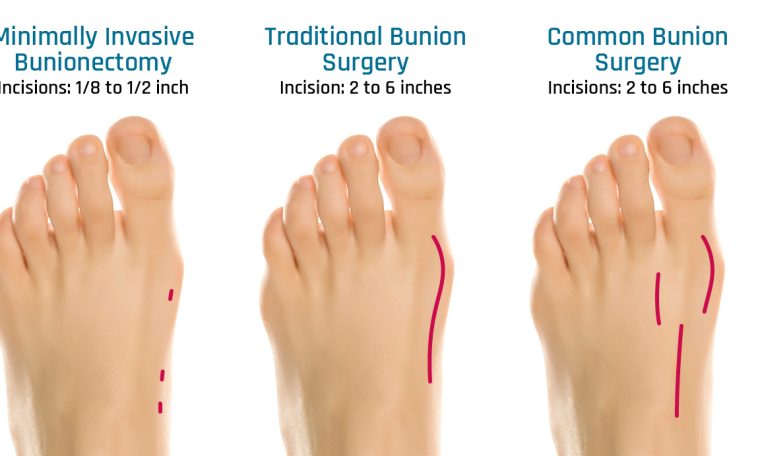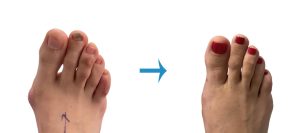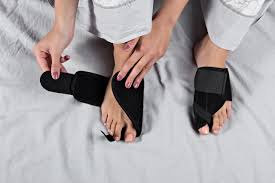
Bunions, a common foot ailment, can be both painful and aesthetically displeasing. Traditional bunion correction surgeries often involve significant incisions and prolonged recovery periods. However, the advent of minimally invasive bunion correction techniques has transformed the landscape of bunion treatment, offering patients a more comfortable and efficient path to recovery.
Understanding Bunions: Unraveling the Anatomy of Discomfort
Bunions, or Hallux valgus, are bony protrusions that develop at the joint of the big toe. They often result from a misalignment of the metatarsophalangeal (MTP) joint, causing the big toe to lean towards the second toe. This misalignment leads to the formation of a bony bump on the side of the foot, accompanied by pain, swelling, and difficulty finding suitable footwear.
Traditional Bunion Correction: The Drawbacks of Conventional Approaches
Traditional bunion correction surgeries typically involve open procedures where large incisions are made to access the bunion and realign the bones. While effective, these procedures come with drawbacks, including longer recovery times, increased postoperative pain, and noticeable scarring. The extended recovery period often discourages individuals from seeking timely treatment for their bunions.
The Paradigm Shift: Embracing Minimally Invasive Techniques
Minimally invasive bunion correction represents a paradigm shift in the approach to treating bunions. This innovative technique aims to address the misalignment and deformity associated with bunions through smaller incisions and specialized instruments. The focus is on achieving precise correction while minimizing tissue damage, allowing for quicker recovery, and reducing postoperative discomfort.
Key Advantages of Minimally Invasive Bunion Correction

- Smaller Incisions, Lesser Scarring: The most visible advantage of minimally invasive bunion correction is the use of smaller incisions, resulting in minimal scarring. This cosmetic benefit is particularly appealing to individuals concerned about the appearance of surgical scars.
- Quicker Recovery Times: With reduced tissue trauma, patients undergoing minimally invasive bunion correction often experience quicker recovery times compared to traditional open procedures. This allows individuals to return to their daily activities sooner, contributing to a more seamless transition post-surgery.
- Reduced Postoperative Pain: Smaller incisions and a less invasive approach contribute to reduced postoperative pain. Patients typically report less discomfort during the recovery period, improving the overall experience of bunion correction surgery.
- Preservation of Normal Foot Anatomy: Minimally invasive techniques prioritize the preservation of normal foot anatomy. This approach aims to correct the bunion deformity while minimizing disruption to surrounding structures, ensuring the foot retains its natural functionality.
- Lower Risk of Complications: The minimally invasive approach is associated with a lower risk of complications compared to traditional open surgeries. This includes a decreased likelihood of infections, nerve damage, and other postoperative issues.
The Procedure Unveiled: Navigating the Steps of Minimally Invasive Bunion Correction
- Preoperative Assessment: Before undergoing minimally invasive bunion correction, patients undergo a thorough preoperative assessment. This includes a comprehensive examination of the foot, imaging studies, and a discussion of the patient’s medical history.
- Small Incisions and Visualization: During the procedure, small incisions are made near the bunion. Specialized instruments, including a camera or endoscope, are used to visualize the surgical site. This real-time imaging allows the surgeon to navigate and perform precise corrections.
- Bunion Correction and Bone Alignment: The surgeon uses specialized tools to correct the misalignment of the metatarsophalangeal joint and realign the bones. This may involve removing excess bone, repositioning the metatarsal, and securing the corrected position.
- Internal Fixation: In some cases, internal fixation devices such as screws, pins, or wires may be used to stabilize the corrected bones. These devices promote optimal healing and prevent the recurrence of the bunion deformity.
- Closure and Recovery: After the correction is complete, the small incisions are closed, and the foot is bandaged. The patient is monitored in the recovery area and, if all is well, can often return home the same day.
Patient Experiences: Navigating Success Stories in Minimally Invasive Bunion Correction
The real-life experiences of individuals who have undergone minimally invasive bunion correction provide valuable insights into the transformative impact of this innovative approach. From accelerated recovery to improved overall satisfaction, these success stories highlight the positive outcomes achievable with minimally invasive techniques.
Navigating Misconceptions: Dispelling Myths Surrounding Minimally Invasive Bunion Correction
Despite its proven advantages, minimally invasive bunion correction is sometimes surrounded by misconceptions. Dispelling these myths is crucial for individuals considering this approach. Common misconceptions include doubts about the effectiveness of correction, concerns about the durability of the results, and skepticism regarding the suitability of the procedure for severe bunions.
Postoperative Care: Ensuring Optimal Healing and Long-Term Success

Postoperative care plays a crucial role in the success of minimally invasive bunion correction. Patients are typically provided with specific instructions for foot care, including the proper way to clean and dress the incisions. Surgeons use follow-up appointments to oversee the healing progress and address any emerging concerns.
The Surgeon’s Expertise: A Cornerstone of Successful Minimally Invasive Bunion Correction
The success of minimally invasive bunion correction hinges on the expertise of the surgeon. Choosing a skilled and experienced surgeon who is well-versed in minimally invasive techniques is paramount. Surgeons with a proven track record in bunion correction can tailor the procedure to the individual needs of each patient, maximizing the chances of a successful outcome.
Evaluating Candidacy: Who Is an Ideal Candidate for Minimally Invasive Bunion Correction?
While minimally invasive bunion correction offers numerous benefits, not every individual is an ideal candidate. The evaluation process considers factors like the severity of the bunion, the presence of other foot conditions, and the overall health of the patient. A thorough consultation with a qualified foot specialist is crucial for determining candidacy.
Cost Considerations: Understanding the Financial Aspects of Minimally Invasive Bunion Correction
Factors like the surgeon’s expertise, the facility, and the geographical location can influence the cost of minimally invasive bunion correction. It’s essential for individuals considering this approach to discuss the financial aspects, including insurance coverage and potential out-of-pocket expenses, with their healthcare provider.
Conclusion: A Stride Towards Comfort and Innovation in Bunion Correction
In conclusion, the emergence of minimally invasive bunion correction represents a significant stride toward enhancing patient comfort and optimizing outcomes. Minimally invasive bunion treatment offers benefits like reduced scarring and faster recovery. Embracing this innovation ensures a future of foot health with comfort and confidence.
You can also read our blog: The Advancements of Keyhole Surgery in Singapore: Unveiling



